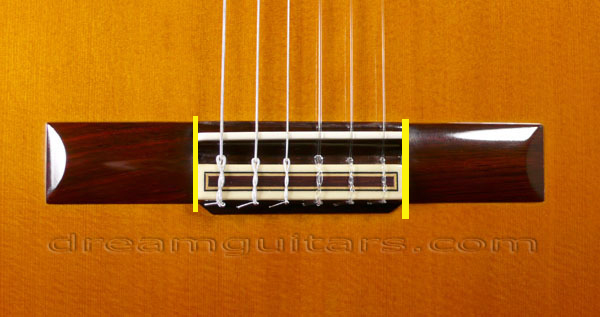Welcome to one of the most active flamenco sites on the Internet. Guests can read most posts but if you want to participate click here to register.
This site is dedicated to the memory of Paco de Lucía, Ron Mitchell, Guy Williams, Linda Elvira, Philip John Lee, Craig Eros, Ben Woods, David Serva and Tom Blackshear who went ahead of us.
We receive 12,200 visitors a month from 200 countries and 1.7 million page impressions a year. To advertise on this site please contact us.
|

|
|
A new visit to bruné
|
You are logged in as Guest
|
|
Users viewing this topic: none
|
|
Login  | |
|

   
HemeolaMan
Posts: 1514
Joined: Jul. 13 2007
From: Chicago

|
 A new visit to bruné A new visit to bruné
|
|
|
I visited R.E Bruné again today and we had a good long chat about some of the finer points of guitar making and some of his firmly held beliefs. it was refreshing and interesting, and I will share some of the topics with you!
He stressed the importance of a well made bridge. He told me that many makers ignore it, and visually if you look at the physics of the guitar, it only makes sense to invest time in the bridge.
As the natural fulcrum point, it is the strings access to the top, so no matter what the bracing structure or top wood or plantilla, it is the bridge that has most to do with the sound of the maker.
I also learned that even though lutes look like they´d have kerfing inside, they actually do not. the really only have about 1 mm to .75 mm of gluing surface in contact with the top all the way around!!!
I asked him if the same principle could be applied to guitar and he said that it could indeed, and that most guitars were braced and kerfed to heavily.
It was clear that in his studies and many builds he has found that a minimal amount of structural intervention is necessary. he does however strictly believe in the ricght kerf width for saw blades so that the sides join the neck perfectly, and INCREDIBLY SHARP TOOLS!!!!.
we discussed sharpening stones and he mentioned going up to 30,000 grit!!! they are mirror polished!
I was also impressed by the 51´barbero, the very same one in the plans from GAL, which was a fun guitar!
Another interesting one was a 1860´s torres, which was an astonishingly nice instrument, and incredibly light and thin (1.5 mm on the top!!!) I didnt have the heart to play it very much, but richard demo'd it for me, wonderful sound
Also, a 1970's reyes. Lemme tell ya, the buzz about reyes is true! fantastic fantastic fantastic, just a sublime instrumet!
_____________________________
[signature][/signature]
|
|
|
|
REPORT THIS POST AS INAPPROPRIATE |
Date Aug. 19 2008 17:57:24
 |
|

  
Anders Eliasson
Posts: 5780
Joined: Oct. 18 2006

|
 RE: A new visit to bruné (in reply to HemeolaMan) RE: A new visit to bruné (in reply to HemeolaMan)
|
|
|
Ok, there are many different ideas out there by different builders.
I personally dont need a louder bassier response, so I´ll stick with what I´ve got until now.
But I agree that the bridge is very important, so here´s my ideas, which I think are very general.
Mass. The bridge should be light. A flamenco bridge I make with the wings around 3,5mm thick and 5,5mm at the centre. Using a good piece of wood is important. The important factors are mass and damping effect. I find that the best bridge material I can get now is Indian rosewood. It has a very low damping effect and is not to heavy and besides consistancy is VERY high. When I buy bridges, I can pick up 20 - 30 or more bridge planks which are basically identical. Madagascar rosewood an be very good as well, but its a lot more difficult to find good quality. A lot of it is a bit loose in the pores.
Braz rosewood used to be the thing, but just as on backs and sides, what is sold as Braz rosewood is very often something brown and heavy with a strange smell, where you have no idea what you get. I have decided to completely stop using Braz wood
Design. I think a flamenco bridge should always be made with 12 holes, because it gives you the chance of maintaining a high breakangle even when the guitar gets old and he holes get worn out. Remember that because a bridge has 12 holes, you are not obliged to use them. Its an option. You can tie with 6 holes if you prefer the sound and playabilty of that.
Besides that accuracy in making the saddle slot and saddle is very iportant
_____________________________
Blog: http://news-from-the-workshop.blogspot.com/
|
|
|
|
REPORT THIS POST AS INAPPROPRIATE |
Date Aug. 20 2008 22:59:22
 |
|

   
HemeolaMan
Posts: 1514
Joined: Jul. 13 2007
From: Chicago

|
 RE: A new visit to bruné (in reply to Anders Eliasson) RE: A new visit to bruné (in reply to Anders Eliasson)
|
|
|
I do recall discussing break angle with him.
He apparently has investigated the physics and along with others, have concluded that it has no effect. Only to the extent of having adequate downpressure. I guess the caveat there is that if a string has enough down pressure in the first place, adding more doesnt change much.
I disagree, because i have retrofitted a guitar with a 12 hole bridge and seen the difference. But, i can see were he is coming from in the overall perspective, its not going to change much.
I do like 12 hole bridges, I think they look neat and trim instead of all those silly knots hanging about.
he did mention that i would need to drop about a grand on sharpening stones, shaptons he recommended.
apparently going all the way up to 30,000 grit! I dont have that kind of money, and I ould be interested in how sharp I really need to make my tools, considering I am NOT a master luthier and I am unlikely to EVER be one.
Respect to the man, but I'm on a budget!!! I trust his advice, but frankly I cant afford it at all!
_____________________________
[signature][/signature]
|
|
|
|
REPORT THIS POST AS INAPPROPRIATE |
Date Aug. 21 2008 11:30:20
 |
|

   
Tom Blackshear
Posts: 2304
Joined: Apr. 15 2008

|
 RE: A new visit to bruné (in reply to HemeolaMan) RE: A new visit to bruné (in reply to HemeolaMan)
|
|
|
quote:
ORIGINAL: HemeolaMan
I visited R.E Bruné again today and we had a good long chat about some of the finer points of guitar making and some of his firmly held beliefs. it was refreshing and interesting, and I will share some of the topics with you!
He stressed the importance of a well made bridge. He told me that many makers ignore it, and visually if you look at the physics of the guitar, it only makes sense to invest time in the bridge.
As the natural fulcrum point, it is the strings access to the top, so no matter what the bracing structure or top wood or plantilla, it is the bridge that has most to do with the sound of the maker .quote:
This is true if everything else stays the same as the original maker intended. Things can be adjusted to change sound if other parts of the guitar are changed. If it is a repair and it is to keep the original intent, let's say a master's instrument, then the bridge should have the same size, shape, and mass, or weight to it.
I ran into a slight problem with the Miguel Rodriguez bridge which was too thin, in my opinion, with the holes toward the upper part of the tie block. I kept the same mass but I moved the holes down a little to give more mass to the upper part of the tie block.
This made the string holes closer to the top's surface, and I think it actually improved the sound. The bridge mass wasn't changed but the holes being closer down toward the top improved the sound a little, perhaps by giving a better break angle over the saddle and also gave better support for less string wear on the tie block.
But let's say I'm building other masters' guitar designs with the same bridge and I want to define my own sound. What would I do then? My point here is that fine-tuning will bring sound into the space where other designs don't necessarily go. This is due to slight changes inside the box to comply with that same bridge and its attributes. This works all the time for me, so I don't try and duplicate the exact sound of the masters' but try and make them better due to the articulation, volume, and speed with which a players technique will be enhanced.
_____________________________
Tom Blackshear Guitar maker
|
|
|
|
REPORT THIS POST AS INAPPROPRIATE |
Date Aug. 23 2008 18:30:28
 |
|

  
Anders Eliasson
Posts: 5780
Joined: Oct. 18 2006

|
 RE: A new visit to bruné (in reply to HemeolaMan) RE: A new visit to bruné (in reply to HemeolaMan)
|
|
|
quote]I may have to "improve" the barbero design then... assuming the alterations i make are improvements! lol [/quote]
So how will you improve the sound and have you ever heard the originals sound?
Since these discussions always end "up in the air" with a lot of things being said which cannot be justified in a forum discussion, I always feel they are empty. I could continue in this line saying how I adjust and fine tune, tweak etc, but it´ll just be another set of word babble that will make very little real sence. We can all have these ideas of how we can make a guitar or the world for that matter, better, but often its just intellectual babble just like when all the intellectual hippie communists, anarchists, troskists etc talked about changing the world. It was all in their head, totally mental babble which didnt lead to anything but frustrations.
I dont say that they were wrong not at all, just that as long as things only are in your mind, they are not really worth a lot.
Back to guitars... I dont say that you cant improve, of course you can and I will personally always try to improve. Many things are intuitional, but they have to be proven and you can only proove very few things or one thing a time, so here comes experience, patience and method. And if you dont have all three factors, yoú´ll end up with walking around blind. I have tried many guitars from very experienced builders which were bad, because they were just experimenting with something new all the time.
So go slow and be methodical, if not, you wont have an idea of what you are doing.
_____________________________
Blog: http://news-from-the-workshop.blogspot.com/
|
|
|
|
REPORT THIS POST AS INAPPROPRIATE |
Date Aug. 24 2008 23:22:32
 |
|

   
Tom Blackshear
Posts: 2304
Joined: Apr. 15 2008

|
 RE: A new visit to bruné (in reply to HemeolaMan) RE: A new visit to bruné (in reply to HemeolaMan)
|
|
|
quote:
ORIGINAL: HemeolaMan
chiefly, the flexibility of the center of the bridge, as in the part with the saddle in it, contributes to bass response.
i guess reyes or barbero (cant remember which) used to make a cut on either side of the tie block/saddle area which allowed the central portion to vibrate more freely and i think this gavea louder bassier response. i think thats perhaps what he was getting at, i'll upload a pic of the section im talking about.
Please ask me more questions, so much was talked about i may be forgetting to mention stuff!

The tie block area is designed for stiffer or softer quality, which is higher or deeper frequency, as with the Santos which is about 3-3/8" across to where the Reyes is 3-1/4" across.
Also, the Santos top is not as wide as the Reyes so the Santos bridge is a little shorter in its length; implying that its bridge arms are shorter and stiffer because its tie block is longer. So, yes, bridges do contribute to sound and the higher frequencies or lower frequencies.
Images are resized automatically to a maximum width of 800px
_____________________________
Tom Blackshear Guitar maker
|
|
|
|
REPORT THIS POST AS INAPPROPRIATE |
Date Aug. 25 2008 6:41:28
 |
|

   
HemeolaMan
Posts: 1514
Joined: Jul. 13 2007
From: Chicago

|
 RE: A new visit to bruné (in reply to Anders Eliasson) RE: A new visit to bruné (in reply to Anders Eliasson)
|
|
|
anders, I have played it. it is in his collection. he of course, played it far better than I did lol. I understand your point of view on the excessive internet babble,
consider however, That I am taking the time to ask about the fine points of a part of the instrument that until now i didnt think was significant.
slow and methodical is the only way i can do this! lol, which is why i ask you guys and brune for advice, because you guys already know the tricks!
Tom, I appreciate the inside pointers there, I had discussed the flat toppedness with brune, and I was surprised to learn that he thought doming was of little importance!! lol, imagine my dismay when i found out that doming isnt really that big a deal lol.
i have always wondered about bridge patches though, i see them in plans sometimes, but there's never really any talk of that they do... would the sanding to create a flex point be sort of the opposite of a bridge patch's job?
_____________________________
[signature][/signature]
|
|
|
|
REPORT THIS POST AS INAPPROPRIATE |
Date Aug. 25 2008 18:33:21
 |
|

  
Anders Eliasson
Posts: 5780
Joined: Oct. 18 2006

|
 RE: A new visit to bruné (in reply to HemeolaMan) RE: A new visit to bruné (in reply to HemeolaMan)
|
|
|
quote:
i have always wondered about bridge patches though, i see them in plans sometimes, but there's never really any talk of that they do... would the sanding to create a flex point be sort of the opposite of a bridge patch's job?
The bridge path is one of the more controversial parts of a guitars design and I will recommend you to not mix it with the graduation of the top at this point.
In general the bracing layout of a flamenco guitar is much more parallel than on a classical. This in order to make the top looser and with less harmonics and sustain... Flamenco
The Bridge patch makes the guitar stiffer cross the grain, especially if its going almost all the way across the lower bout as on some Barbero designs and TB´s Reyes Plan. This of course adds more harmonics and some more sustain to the design, and that was the reason Barbero started using a bridge path, because he said that it was what the "modern" players of his time were looking for.
I have made the same design without a bridge path, a short patch and a long one. The sound is different, but not that much, and I clearly find that the long bridge patch helps me making an even output. This because the bridge patch helps controling the shape or dome of the top. There is a tendency on guitars without a bridge patch and with a thin top to have some problems with the doming. The bridge can lift so much that the top between the bridge and the side of the guitar can sink. This I dont like at all. It sometimes provokes cracks right where the bridge end because its a stress point.
The bridge patch I use now is long, almost from side to side, very thin, (1,5mm in the center and close to nothing towards the side) its also very narrow, something like 60 or 70% of the patch on TB´s Reyes plan.
I find this patch to be "enough" It controls without trading to much off in terms to much harmonics and sustain.
In the end, you´ll have to find your own way. Its a long but very inspiring way.
I hope this wasn´t to much word babble. 
Anders
_____________________________
Blog: http://news-from-the-workshop.blogspot.com/
|
|
|
|
REPORT THIS POST AS INAPPROPRIATE |
Date Aug. 26 2008 13:34:25
 |
|
 New Messages New Messages |
 No New Messages No New Messages |
 Hot Topic w/ New Messages Hot Topic w/ New Messages |
 Hot Topic w/o New Messages Hot Topic w/o New Messages |
 Locked w/ New Messages Locked w/ New Messages |
 Locked w/o New Messages Locked w/o New Messages |
|
 Post New Thread
Post New Thread
 Reply to Message
Reply to Message
 Post New Poll
Post New Poll
 Submit Vote
Submit Vote
 Delete My Own Post
Delete My Own Post
 Delete My Own Thread
Delete My Own Thread
 Rate Posts
Rate Posts
|
|
|
Forum Software powered by ASP Playground Advanced Edition 2.0.5
Copyright © 2000 - 2003 ASPPlayground.NET |
6.201172E-02 secs.
|


 Printable Version
Printable Version










 New Messages
New Messages No New Messages
No New Messages Hot Topic w/ New Messages
Hot Topic w/ New Messages Hot Topic w/o New Messages
Hot Topic w/o New Messages Locked w/ New Messages
Locked w/ New Messages Locked w/o New Messages
Locked w/o New Messages Post New Thread
Post New Thread